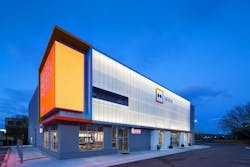Rewriting history: Legacy building conversions spur redevelopment in America’s older cities
By Mike Plotnick, Contributing Editor
Businesses, developers, and civic leaders are repurposing existing structures to celebrate history, attract tenants, and serve as a catalyst for future development.
In Flint, Mich., an 1895 brick structure considered the birthplace of the global auto industry has been reimagined as a community resource and showcase of the legacy of General Motors. Located on the city’s riverfront, the former carriage-assembly building now houses offices, event space, a heritage center, and a research library with archives from Kettering University (formerly General Motors Institute).
SmithGroupJJR oversaw the restoration to help GM preserve its heritage with the city and spur economic development. “Across the country, we’re seeing that the historic preservation and restoration of a single building can reenergize an entire urban district,” says Lise Newman, AIA, SmithGroupJJR’s Director of the Workplace Practice.
In Atlanta’s Buckhead neighborhood, the former headquarters of lease-to-own retailer Aarons is being turned into the 309 East Paces Ferry office/retail complex. Former Aaron’s CEO Robin Loudermilk partnered with developers Knox Properties and the Redan Group to redevelop the 11-story tower.
ALSO SEE: BD+C Giants 300 reconstruction giants
Top 160 reconstruction architecture firms
Top 105 reconstruction engineering firms
Top 115 reconstruction construction firms
Balfour Beatty collaborated with architect Lyman Davidson Dooley to implement Lean construction and offsite fabrication of the building’s exterior wall panels. “In a span of 25 working days, we clad the whole exterior, using a third of the workforce required by traditional construction,” says Mike Macon, VP and Business Unit Leader at Balfour Beatty.
Shuttered retail spaces are also ripe for redevelopment. A former Borders bookstore in Omaha, Neb., was transformed into Do Space, a digital library and community education center. HDR worked with civic leaders to explore the library-of-the-future concept. “It’s a community information hub, providing technology access to everyone for free,” says HDR Design Principal David Lempke, AIA.
